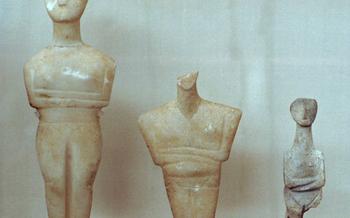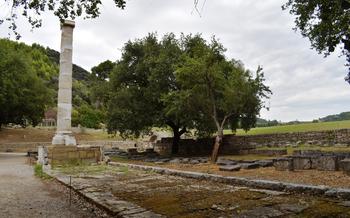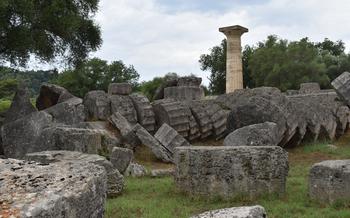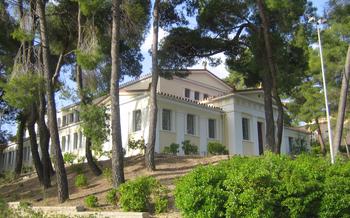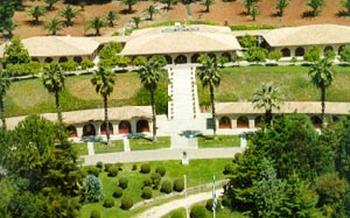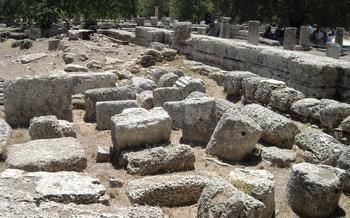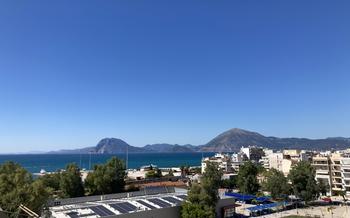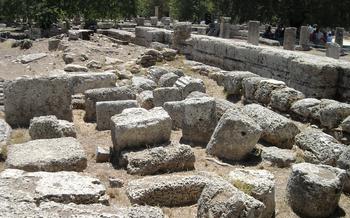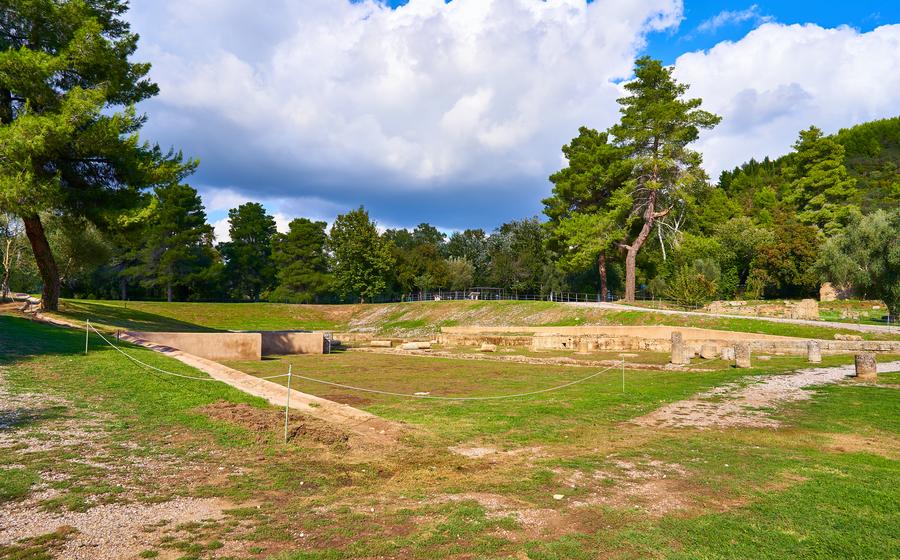
Gymnasium of Olympia
- The Gymnasium of Olympia: Antiquity's Corner of Champions
- A Walk Through History: Exploring the Past
- Uncovering Olympia's Secrets: A Guided Tour
- Witnessing the Glory Days: Ancient Olympic Games
- Echoes of Chariot Races: The Hippodrome
- Theodoros' Legacy: Sculpting Perfection
- Practicalities: Planning Your Visit
- Capture the Moment: Photo Opportunities
- Local Insights: Engaging with the Community
- Beyond Olympia: Exploring the Peloponnese
- Mythological Tales: Gods and Heroes
- Insider Tip: Off-Season Magic
The Gymnasium of Olympia: Antiquity's Corner of Champions
In the heart of ancient Olympia, where legends intertwine with history, lies the Gymnasium, a testament to the birthplace of the Olympic Games. Constructed in the 5th century BC, this remarkable complex served as a training ground for athletes who sought glory and honor in the arena of competition. As visitors step into the Gymnasium today, they are transported back in time to an era when physical prowess and the pursuit of excellence reigned supreme.
The Gymnasium's imposing Doric columns, evoking a sense of strength and grandeur, once resonated with the grunts and cheers of athletes as they pushed their limits in preparation for the Olympic Games. This sacred space witnessed the birth of champions, whose dedication and perseverance propelled them to legendary status. The Gymnasium stands as a symbol of human endeavor, reminding us of the enduring power of sport to inspire, unite, and transcend the boundaries of time.
A Walk Through History: Exploring the Past
Olympia, the birthplace of the ancient Olympic Games, holds a wealth of historical significance that transports visitors back in time. The Gymnasium of Olympia, a central part of this ancient sporting complex, played a crucial role in shaping the athletic traditions and ideals of the ancient Greeks.
The gymnasium, constructed in the 5th century BC, served as a training ground for athletes preparing for the Olympic Games. It comprised various facilities, including a palestra for wrestling and boxing, a hippodrome for chariot racing, and a stadium for running and other athletic events.
During the Olympic Games, the gymnasium buzzed with activity as athletes from across the Greek world gathered to compete in a spirit of friendly rivalry. The games were not merely sporting events but also religious festivals honoring Zeus, the king of the gods.
Training methods in ancient Greece emphasized physical fitness, discipline, and mental fortitude. Athletes underwent rigorous training regimens, adhering to strict diets and exercise routines. They believed in the holistic development of the mind, body, and spirit, striving for excellence in all aspects of life.
Exploring the Gymnasium of Olympia today allows visitors to immerse themselves in this rich history. The ruins of the ancient structures, including the palestra, hippodrome, and stadium, provide a glimpse into the world of ancient Greek athletes and the origins of modern sports.
Uncovering Olympia's Secrets: A Guided Tour
To delve deeper into the wonders of Olympia and gain exclusive insights, consider embarking on a guided tour. Knowledgeable and passionate guides will lead you on an immersive journey through time, revealing hidden stories and intriguing details that bring the ancient site to life.
Benefits of a Guided Tour:
-
Personalized Experience: Guides cater to your specific interests, providing tailored explanations and answering your questions.
-
Historical Expertise: Learn from experts who specialize in ancient Greek history and archaeology, ensuring accurate and comprehensive information.
-
Captivating Storytelling: Guides weave captivating narratives, bringing the past alive through engaging storytelling techniques.
Available Tour Options:
-
Group Tours: Join a small group of like-minded travelers for a shared exploration of Olympia. Group tours offer a social and interactive experience, allowing you to exchange ideas and perspectives with fellow enthusiasts.
-
Private Tours: Opt for a private tour for an exclusive and customized experience. Private tours provide undivided attention from your guide, ensuring a personalized itinerary that caters to your specific interests and pace.
Duration and Pricing:
-
Duration: Guided tours typically last between 5 to 3 hours, allowing ample time to explore the Gymnasium and other significant landmarks within the archaeological site.
-
Pricing: Costs vary depending on the tour type, group size, and inclusions. Expect to pay around €15-€25 for a group tour and €50-€100 for a private tour.
Witnessing the Glory Days: Ancient Olympic Games
The ancient Olympic Games were not merely sporting events; they were a sacred and awe-inspiring spectacle deeply embedded in Greek culture. Held every four years in honor of Zeus, the king of the gods, these games brought together athletes, spectators, and dignitaries from across the Hellenic world.
The competitions, which included foot races, wrestling, boxing, chariot racing, and the pentathlon, were a showcase of human excellence and a testament to the Greek emphasis on physical and mental prowess. Victors were celebrated as heroes and showered with glory, their names forever inscribed in the annals of Olympic history.
Beyond the athletic contests, the games were a time of peace and unity, a sacred truce declared throughout Greece to ensure the safe passage of athletes and visitors. The Olympic Games were also a religious festival, with rituals and sacrifices performed to honor Zeus and other deities.
The legacy of the ancient Olympic Games is immense, extending far beyond the realm of sports. They laid the foundation for the modern Olympic movement, revived in the late 19th century, and continue to inspire athletes and spectators worldwide. The Olympic spirit of excellence, fair play, and international camaraderie remains a beacon of hope and unity in a world often divided.
Echoes of Chariot Races: The Hippodrome
The Hippodrome, an ancient stadium dedicated to chariot racing, stands as a testament to the Greeks' passion for speed and competition. Located just south of the Gymnasium, this impressive structure once hosted thrilling races that captivated spectators from across the Hellenic world.
The Hippodrome's layout mirrored that of a modern racetrack, with a long, narrow course flanked by seating stands. The track itself was approximately 600 meters in length, allowing for exhilarating races that tested the skills of both drivers and horses.
During the Olympic Games, chariot racing was one of the most popular events, drawing massive crowds eager to witness the spectacle. The races were fiercely competitive, with teams from various city-states vying for victory. The atmosphere was electric as the chariots thundered around the track, their drivers urging their horses to ever-greater speeds.
The Hippodrome's design ensured that spectators had an unobstructed view of the action. The seating stands rose in tiers, providing a panoramic vista of the entire track. Spectators could cheer on their favorite teams, marvel at the skill of the drivers, and experience the adrenaline-pumping excitement of the races.
Today, the Hippodrome stands as a silent reminder of the ancient Olympic Games' grandeur. Although the chariots and horses are long gone, the spirit of competition and the echoes of cheering crowds still linger in the air, inviting visitors to imagine the spectacle that once unfolded on this historic ground.
Theodoros' Legacy: Sculpting Perfection
Among the many renowned artists associated with Olympia, Theodoros of Samos stands out as a master sculptor who left an indelible mark on the ancient world. His contributions to the Gymnasium and other sacred sites in Olympia earned him a place among the most celebrated artists of antiquity.
Theodoros is credited with creating the famous statue of Zeus at Olympia, which was considered one of the Seven Wonders of the Ancient World. This colossal masterpiece, carved from ivory and gold, was housed in the Temple of Zeus and attracted pilgrims and visitors from far and wide.
Beyond the iconic Zeus statue, Theodoros is also known for his skillful depictions of athletes in bronze. His sculptures captured the essence of athleticism, portraying the physiques, movements, and expressions of the competitors with remarkable accuracy and detail.
Theodoros's artistic style was characterized by a deep understanding of human anatomy and a keen eye for proportion. His works exuded a sense of realism and vitality, bringing the athletes to life in a way that resonated with both contemporaries and future generations.
The legacy of Theodoros lives on in the numerous sculptures that have survived to this day. These masterpieces continue to inspire awe and admiration, showcasing the extraordinary talent and artistry of this ancient Greek sculptor.
Practicalities: Planning Your Visit
Opening hours and ticket prices
The Gymnasium of Olympia is open to the public daily from 8 am to sunset. The entrance fee for the archaeological site of Olympia, which includes the Gymnasium, is €12 for adults, €6 for students and seniors, and free for children under 6 years old.
Getting to Olympia: Transportation options
Olympia is located in the Peloponnese region of Greece, about 300 kilometers west of Athens. The easiest way to get to Olympia is by car, which takes about 3 hours from Athens. You can also take a bus from Athens to Olympia, which takes about 4 hours.
Accessibility for visitors with disabilities
The Gymnasium of Olympia is wheelchair accessible. There are ramps and elevators throughout the site, and accessible restrooms are available.
Additional Tips
- Wear comfortable shoes, as you will be doing a lot of walking.
- Bring water and sunscreen, as there is little shade at the site.
- If you are visiting during the summer, be sure to start your visit early in the morning to avoid the heat.
Capture the Moment: Photo Opportunities
The Gymnasium of Olympia offers a treasure trove of photo opportunities for history buffs and photography enthusiasts alike. With its ancient architecture, lush greenery, and captivating views, the site provides a stunning backdrop for capturing memorable images.
Scenic Spots Within the Gymnasium:
The Palestra: This wrestling training area features well-preserved columns and a picturesque courtyard, creating a serene and atmospheric setting for photographs.
The Leonidaion: Capture the grandeur of this Spartan residence with its impressive columns and intricate architectural details.
The Hippodrome: The starting gates and the vast expanse of the track offer unique perspectives for capturing the essence of ancient chariot racing.
Theodoros' Sculptures: Immortalize the beauty of Theodoros' masterpieces, such as the famous Zeus statue or the sculptural decorations of the Temple of Zeus.
Tips for Capturing Stunning Images:
Golden Hour Magic: Arrive early in the morning or late in the afternoon to take advantage of the golden hour lighting, which casts a warm and inviting glow on the ancient ruins.
Experiment with Angles: Don't be afraid to explore different angles and perspectives. Try shooting from ground level or from elevated viewpoints to add depth and interest to your shots.
People and Nature: Include people in your photos to give a sense of scale and life to the ancient surroundings. Incorporate elements of nature, such as trees or flowers, to add color and vibrancy to your compositions.
Storytelling Through Images: Think about the story you want to tell with your photographs. Capture the essence of ancient Olympia by focusing on details, textures, and interactions that convey the site's historical significance.
Sharing Your Memories Online:
Share your stunning captures with the world on social media, using relevant hashtags like #Olympia, #AncientGreece, and #TravelPhotography. Tag the official Olympia Museum or tourism board accounts to increase your visibility and connect with fellow enthusiasts.
Local Insights: Engaging with the Community
As you wander through the Gymnasium, don't miss the opportunity to connect with the local community. Olympia's residents are proud of their heritage and eager to share their stories and insights with visitors. Strike up a conversation at a local café, visit the bustling market, or join a guided tour led by a knowledgeable local guide. These interactions will provide you with a deeper understanding of Olympia's culture and history, and you may even uncover hidden gems that are off the beaten path.
For a truly immersive experience, consider staying at a traditional guesthouse or bed and breakfast. This will allow you to interact with local families and learn about their daily lives. You'll be treated to delicious home-cooked meals, warm hospitality, and personalized recommendations for exploring the area.
By engaging with the local community, you'll gain a richer and more fulfilling experience of Olympia. Embrace the opportunity to connect with the people who call this ancient land home, and you'll leave with a deeper appreciation for the region's culture, history, and spirit.
Beyond Olympia: Exploring the Peloponnese
Olympia, with its rich history and iconic landmarks, is undoubtedly the crown jewel of the Peloponnese region. However, venturing beyond Olympia's boundaries will reveal a treasure trove of additional historical sites and natural wonders waiting to be discovered.
A short drive from Olympia lies the ancient city of Mycenae, renowned for its impressive fortifications and the legendary Lion Gate. Step through the gate and immerse yourself in the tales of Agamemnon and the House of Atreus. Explore the ruins of the palace, marvel at the awe-inspiring tholos tombs, and let your imagination transport you back to the Mycenaean era.
Another must-visit destination is Epidaurus, home to one of the best-preserved ancient theaters in the world. The Epidaurus Theater, with its exceptional acoustics and stunning hillside setting, is a testament to the architectural brilliance of the ancient Greeks. Attend a performance in this magnificent theater and experience the magic of ancient drama come to life.
For those seeking a unique natural wonder, the Diros Caves offer a subterranean adventure like no other. Explore the labyrinthine network of underground chambers, marvel at the glistening stalactites and stalagmites, and take a boat ride on the crystal-clear waters of the underground river.
The Peloponnese region is a rich tapestry of history, culture, and natural beauty, offering an abundance of day trip options and extended itineraries for those seeking a deeper exploration. Whether you're a history buff, an outdoor enthusiast, or simply a curious traveler, the Peloponnese has something to offer everyone.
Mythological Tales: Gods and Heroes
Olympia is deeply entwined with Greek mythology, a realm where gods and heroes played a pivotal role in the ancient games. Zeus, the king of the gods, was revered as the patron deity of Olympia, and his colossal statue, crafted by the renowned sculptor Phidias, stood majestically within the temple dedicated to him. During the games, athletes and spectators alike sought divine favor by offering sacrifices and prayers to Zeus and other deities.
Legends abound about the origins of the Olympic Games. One tale speaks of a footrace between Pelops and Oenomaus, a contest that determined the fate of Pelops' love, Hippodamia. Another myth tells of Hercules, the mighty son of Zeus, who is said to have established the games in honor of his father.
These myths and legends added an aura of sacredness and grandeur to the ancient Olympic Games. Athletes were not merely competing for victory but also seeking the blessings and recognition of the gods. The games were a time of celebration, not only of physical prowess but also of the divine presence that permeated every aspect of ancient Greek life.
In the stories of gods and heroes, we find the essence of what made the ancient Olympic Games so much more than just an athletic competition. They were a sacred ritual, a testament to the deep connection between the Greeks and their deities, and a celebration of the human spirit's ability to achieve greatness with divine guidance.
Insider Tip: Off-Season Magic
While the allure of Greece beckons visitors year-round, there's a hidden charm in exploring Olympia during the off-season. As the summer crowds dissipate, a serene tranquility envelops the ancient site, allowing you to immerse yourself in its history and grandeur without the hustle and bustle.
Imagine strolling through the Gymnasium, marveling at the architectural wonders and imagining the footsteps of ancient athletes echoing through the centuries. The absence of throngs of tourists grants you an intimate encounter with Olympia's past, enabling you to connect with the spirit of the ancient games on a deeper level.
Moreover, the off-season unveils a different facet of Olympia's beauty. The landscape transforms into a tapestry of autumnal hues or bursts forth in vibrant springtime colors, creating a breathtaking backdrop for your exploration. The cooler temperatures, too, make for a more pleasant and leisurely visit, allowing you to savor the nuances of each site without the discomfort of sweltering heat.
Embrace the opportunity to engage with the locals, who are more than eager to share their stories and insights about Olympia's rich heritage. Delve into the local tavernas, indulge in traditional Greek cuisine, and soak up the warmth and hospitality that are synonymous with this proud region.
The off-season in Olympia is a time for reflection, discovery, and profound connection with the essence of this ancient land. Seize the chance to experience its magic and uncover the hidden treasures that await those who venture beyond the peak tourist season.
